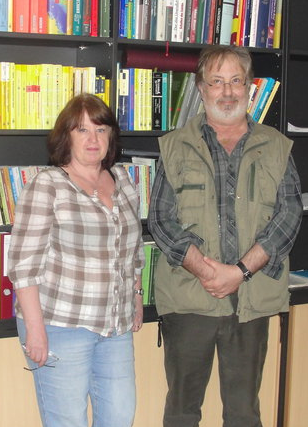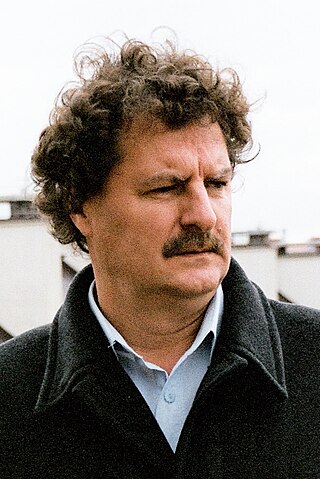Related Research Articles
In theoretical physics, twistor theory was proposed by Roger Penrose in 1967 as a possible path to quantum gravity and has evolved into a widely studied branch of theoretical and mathematical physics. Penrose's idea was that twistor space should be the basic arena for physics from which space-time itself should emerge. It has led to powerful mathematical tools that have applications to differential and integral geometry, nonlinear differential equations and representation theory, and in physics to general relativity, quantum field theory, and the theory of scattering amplitudes. Twistor theory arose in the context of the rapidly expanding mathematical developments in Einstein's theory of general relativity in the late 1950s and in the 1960s and carries a number of influences from that period. In particular, Roger Penrose has credited Ivor Robinson as an important early influence in the development of twistor theory, through his construction of so-called Robinson congruences.
In mathematics, the Hilbert–Pólya conjecture states that the non-trivial zeros of the Riemann zeta function correspond to eigenvalues of a self-adjoint operator. It is a possible approach to the Riemann hypothesis, by means of spectral theory.
In quantum mechanics, einselections, short for "environment-induced superselection", is a name coined by Wojciech H. Zurek for a process which is claimed to explain the appearance of wavefunction collapse and the emergence of classical descriptions of reality from quantum descriptions. In this approach, classicality is described as an emergent property induced in open quantum systems by their environments. Due to the interaction with the environment, the vast majority of states in the Hilbert space of a quantum open system become highly unstable due to entangling interaction with the environment, which in effect monitors selected observables of the system. After a decoherence time, which for macroscopic objects is typically many orders of magnitude shorter than any other dynamical timescale, a generic quantum state decays into an uncertain state which can be expressed as a mixture of simple pointer states. In this way the environment induces effective superselection rules. Thus, einselection precludes stable existence of pure superpositions of pointer states. These 'pointer states' are stable despite environmental interaction. The einselected states lack coherence, and therefore do not exhibit the quantum behaviours of entanglement and superposition.
Quantum metrology is the study of making high-resolution and highly sensitive measurements of physical parameters using quantum theory to describe the physical systems, particularly exploiting quantum entanglement and quantum squeezing. This field promises to develop measurement techniques that give better precision than the same measurement performed in a classical framework. Together with quantum hypothesis testing, it represents an important theoretical model at the basis of quantum sensing.
Objective-collapse theories, also known as models of spontaneous wave function collapse or dynamical reduction models, are proposed solutions to the measurement problem in quantum mechanics. As with other theories called interpretations of quantum mechanics, they are possible explanations of why and how quantum measurements always give definite outcomes, not a superposition of them as predicted by the Schrödinger equation, and more generally how the classical world emerges from quantum theory. The fundamental idea is that the unitary evolution of the wave function describing the state of a quantum system is approximate. It works well for microscopic systems, but progressively loses its validity when the mass / complexity of the system increases.
Lane P. Hughston is an American mathematician.

Vladimir E. Korepin is a professor at the C. N. Yang Institute of Theoretical Physics of the Stony Brook University. Korepin made research contributions in several areas of mathematics and physics.
The toric code is a topological quantum error correcting code, and an example of a stabilizer code, defined on a two-dimensional spin lattice. It is the simplest and most well studied of the quantum double models. It is also the simplest example of topological order—Z2 topological order (first studied in the context of Z2 spin liquid in 1991). The toric code can also be considered to be a Z2 lattice gauge theory in a particular limit. It was introduced by Alexei Kitaev.

Maurice A. de Gosson, is an Austrian mathematician and mathematical physicist, born in 1948 in Berlin. He is currently a Senior Researcher at the Numerical Harmonic Analysis Group (NuHAG) of the University of Vienna.
The two-state vector formalism (TSVF) is a description of quantum mechanics in terms of a causal relation in which the present is caused by quantum states of the past and of the future taken in combination.

Quantum thermodynamics is the study of the relations between two independent physical theories: thermodynamics and quantum mechanics. The two independent theories address the physical phenomena of light and matter. In 1905, Albert Einstein argued that the requirement of consistency between thermodynamics and electromagnetism leads to the conclusion that light is quantized, obtaining the relation . This paper is the dawn of quantum theory. In a few decades quantum theory became established with an independent set of rules. Currently quantum thermodynamics addresses the emergence of thermodynamic laws from quantum mechanics. It differs from quantum statistical mechanics in the emphasis on dynamical processes out of equilibrium. In addition, there is a quest for the theory to be relevant for a single individual quantum system.
In physics, non-Hermitian quantum mechanics, describes quantum mechanical systems where Hamiltonians are not Hermitian.

Janusz Roman Grabowski Polish mathematician working in differential geometry and mathematical methods in classical and quantum physics.
In quantum mechanics, a quantum speed limit (QSL) is a limitation on the minimum time for a quantum system to evolve between two distinguishable states. QSL are closely related to time-energy uncertainty relations. In 1945, Leonid Mandelstam and Igor Tamm derived a time-energy uncertainty relation that bounds the speed of evolution in terms of the energy dispersion. Over half a century later, Norman Margolus and Lev Levitin showed that the speed of evolution cannot exceed the mean energy, a result known as the Margolus–Levitin theorem. Realistic physical systems in contact with an environment are known as open quantum systems and their evolution is also subject to QSL. Quite remarkably it was shown that environmental effects, such as non-Markovian dynamics can speed up quantum processes, which was verified in a cavity QED experiment.
Nilanjana Datta is an Indian-born British mathematician. She is a Professor in Quantum Information Theory in the Department of Applied Mathematics and Theoretical Physics at the University of Cambridge, and a Fellow of Pembroke College.
Adrian Kent is a British theoretical physicist, Professor of Quantum Physics at the University of Cambridge, member of the Centre for Quantum Information and Foundations, and Distinguished Visiting Research Chair at the Perimeter Institute for Theoretical Physics. His research areas are the foundations of quantum theory, quantum information science and quantum cryptography. He is known as the inventor of relativistic quantum cryptography. In 1999 he published the first unconditionally secure protocols for bit commitment and coin tossing, which were also the first relativistic cryptographic protocols. He is a co-inventor of quantum tagging, or quantum position authentication, providing the first schemes for position-based quantum cryptography. In 2005 he published with Lucien Hardy and Jonathan Barrett the first security proof of quantum key distribution based on the no-signalling principle.
Quantum Theory: Concepts and Methods is a 1993 quantum physics textbook by Israeli physicist Asher Peres. Well-regarded among the physics community, it is known for unconventional choices of topics to include.
Olaf Lechtenfeld is a German mathematical physicist, academic and researcher. He is a full professor at the Institute of Theoretical Physics at Leibniz University, where he founded the Riemann Center for Geometry and Physics.
Robert Schrader was a German theoretical and mathematical physicist. He is known for the Osterwalder–Schrader axioms.

Germán Sierra is a Spanish theoretical physicist, author, and academic. He is Professor of Research at the Institute of Theoretical Physics Autonomous University of Madrid-Spanish National Research Council.
References
- ↑ "The Outstanding Young Persons Report 2015" (PDF). Junior Chamber International Osaka (Japan).
- ↑ "Dorje C Brody | University of Surrey". www.surrey.ac.uk. Retrieved 26 May 2018.
- ↑ Brody, Dorje C; Hook, Daniel W (2009). "Information geometry in vapour–liquid equilibrium". Journal of Physics A: Mathematical and Theoretical. 42 (2): 023001. arXiv: 0809.1166 . Bibcode:2009JPhA...42b3001B. doi:10.1088/1751-8113/42/2/023001. S2CID 118311636.
- ↑ Brody, Dorje C.; Hughston, Lane P. (2001). "Geometric quantum mechanics". Journal of Geometry and Physics. 38 (1): 19–53. arXiv: quant-ph/9906086 . Bibcode:2001JGP....38...19B. doi:10.1016/s0393-0440(00)00052-8. S2CID 17580350.
- ↑ Bender, Carl M.; Brody, Dorje C.; Meister, Bernhard K. (2000). "Quantum mechanical Carnot engine". Journal of Physics A: Mathematical and General. 33 (24): 4427. arXiv: quant-ph/0007002 . Bibcode:2000JPhA...33.4427B. doi:10.1088/0305-4470/33/24/302. ISSN 0305-4470. S2CID 5335.
- ↑ Brody, Dorje C; Hughston, Lane P (2016). "Thermodynamics of quantum heat bath". Journal of Physics A: Mathematical and Theoretical. 49 (42): 425302. arXiv: 1406.5780 . Bibcode:2016JPhA...49.5302B. doi:10.1088/1751-8113/49/42/425302. ISSN 1751-8113. S2CID 53380629.
- ↑ Brody, Dorje C.; Hughston, Lane P. (2005). "Theory of quantum space-time". Proceedings of the Royal Society of London A: Mathematical, Physical and Engineering Sciences. 461 (2061): 2679–2699. arXiv: gr-qc/0406121 . Bibcode:2005RSPSA.461.2679B. CiteSeerX 10.1.1.338.5546 . doi:10.1098/rspa.2005.1457. ISSN 1364-5021. S2CID 18502302.
- ↑ Brody, Dorje C.; Meister, Bernhard K.; Parry, Matthew F. (2012). "Informational inefficiency in financial markets". Mathematics and Financial Economics. 6 (3): 249–259. doi:10.1007/s11579-012-0078-1. ISSN 1862-9679. S2CID 154143369.
- ↑ Brody, Dorje C.; Friedman, Robyn L. (December 2009). "Information of Interest". Risk Magazine: 105–110. arXiv: 0905.0072 . Bibcode:2009arXiv0905.0072B.
- ↑ Brody, Dorje C.; Hughston, Lane P. (2001). "Interest rates and information geometry". Proceedings of the Royal Society of London A: Mathematical, Physical and Engineering Sciences. 457 (2010): 1343–1363. arXiv: 1111.3757 . Bibcode:2001RSPSA.457.1343B. doi:10.1098/rspa.2000.0722. ISSN 1364-5021. S2CID 123528394.
- ↑ "Home - Professor Dorje Brody". www.imperial.ac.uk. Retrieved 20 January 2018.
- ↑ "Information Geometry (Editorial Board)". springer.com. Retrieved 16 September 2018.
- ↑ ORCID. "Dorje Brody (0000-0002-9242-9554) - ORCID". orcid.org. Retrieved 20 January 2018.
- ↑ "Researcher (beta): Dorje C Brody in Publications - Dimensions". app.dimensions.ai. Retrieved 20 January 2018.
- ↑ Bender, Carl M.; Brody, Dorje C.; Jones, Hugh F. (2002). "Complex Extension of Quantum Mechanics". Physical Review Letters. 89 (27): 270401. arXiv: quant-ph/0208076 . Bibcode:2002PhRvL..89A0401B. doi:10.1103/PhysRevLett.89.270401. PMID 12513185. S2CID 11004734.
- ↑ Brody, Dorje C.; Hughston, Lane P.; Macrina, Andrea (2022). Financial Informatics: An Information-Based Approach to Asset Pricing. World Scientific. ISBN 9789811246487.
- ↑ "Altmetric – Hamiltonian for the Zeros of the Riemann Zeta Function". www.altmetric.com. Retrieved 20 January 2018.
- ↑ "Math's $1,000,000 Question Isn't Just for Mathematicians Anymore". WIRED. Retrieved 20 January 2018.
- ↑ "Primzahlen: Kommt der Beweis der Riemann-Hypothese aus der Physik?" (in German). Retrieved 20 January 2018.
- ↑ "New insight into proving math's million-dollar problem: the Riemann hypothesis (Update)" . Retrieved 20 January 2018.
- ↑ "Quantum Physicists Attack the Riemann Hypothesis". Quanta Magazine. Retrieved 20 January 2018.
- ↑ Knudson, Kevin. "A New Approach To The Riemann Hypothesis Could Be Worth $1,000,000". Forbes. Retrieved 26 May 2018.
- ↑ Bellissard, Jean V. (2017). "Comment on "Hamiltonian for the Zeros of the Riemann Zeta Function"". arXiv: 1704.02644 [quant-ph].
- ↑ Bender, Carl M.; Brody, Dorje C.; Müller, Markus P. (18 May 2017). "Comment on 'Comment on "Hamiltonian for the zeros of the Riemann zeta function" '". arXiv: 1705.06767 [quant-ph].
- ↑ Bender, Carl M; Brody, Dorje C (3 April 2018). "Asymptotic analysis on a pseudo-Hermitian Riemann-zeta Hamiltonian". Journal of Physics A: Mathematical and Theoretical. 51 (13): 135203. arXiv: 1710.04411 . Bibcode:2018JPhA...51m5203B. doi:10.1088/1751-8121/aab068. ISSN 1751-8113. S2CID 56086197.